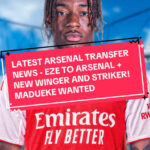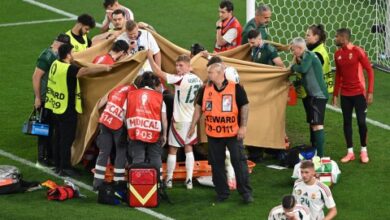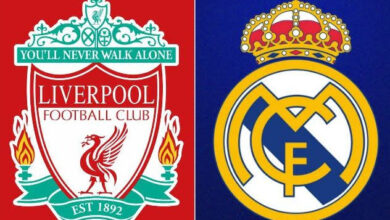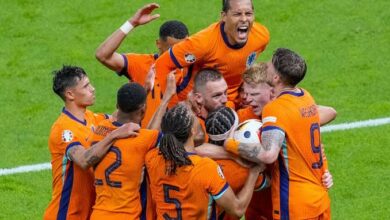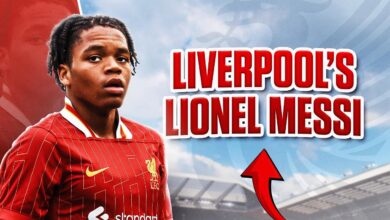Summer Transfer Window Analysis: Major Deals, Strategic Moves, and Market Dynamics
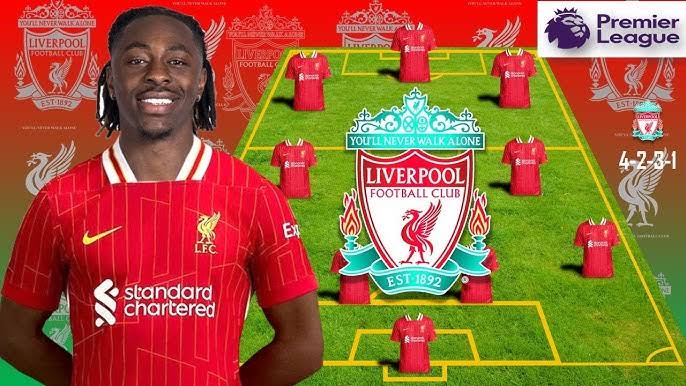
The final fortnight of the summer transfer window has arrived with unprecedented intensity, as Premier League clubs scramble to complete their squads before the deadline. From Tottenham’s ambitious pursuit of Eberechi Eze to Liverpool’s defensive reinforcements and Manchester United’s goalkeeper conundrum, the market dynamics reveal fascinating insights into modern football’s strategic complexities.
Tottenham Hotspur’s pursuit of Crystal Palace winger Eberechi Eze represents one of the most intriguing storylines of the current transfer window. The North London club has positioned themselves strategically to capitalize on Arsenal’s hesitation, with negotiations centering around a substantial £55 million package that could reshape both clubs’ attacking dynamics.
The timing of Spurs’ move demonstrates astute market awareness. James Maddison’s injury has created an urgent need for creative reinforcement, while the approaching expiration of Eze’s release clause adds temporal pressure that benefits decisive action. Arsenal’s prolonged interest without concrete bidding has created precisely the opportunity that Daniel Levy and the Tottenham hierarchy hoped would emerge.
Eze’s potential absence from Crystal Palace’s Premier League opener against Chelsea underscores the advanced nature of these negotiations. Such developments rarely occur without significant progress in contractual discussions, suggesting that personal terms and transfer structure details are being finalized. The 27-year-old’s preference for Arsenal adds complexity, but football history demonstrates that decisive action often overcomes initial preferences when presented with compelling opportunities.l
The strategic implications extend beyond immediate squad strengthening. Eze’s acquisition would represent a significant statement of intent from Tottenham, demonstrating their willingness to compete financially with their North London rivals while addressing tactical needs that have become apparent in early season performances. His versatility across multiple attacking positions provides tactical flexibility that modern football increasingly demands.
Crystal Palace’s perspective reveals the challenging balance between ambition and financial pragmatism that characterizes many Premier League clubs. The substantial fee represents significant resources for squad development, while Eze’s departure would necessitate creative solutions to maintain attacking potency. Reports suggesting interest in Leicester City’s Bilal El Khannouss indicate forward planning that acknowledges the likelihood of Eze’s departure.
Liverpool’s transfer activity reflects a club adapting to new managerial philosophy while addressing structural squad needs. The confirmation of teenage defender Giovanni Leoni’s signing represents long-term strategic thinking that characterizes successful modern football operations. Such acquisitions demonstrate commitment to developing talent while maintaining competitive standards across multiple campaigns.
The ongoing pursuit of Marc Guehi reveals more immediate defensive concerns that require resolution. Crystal Palace’s £45 million valuation, potentially negotiable to £35 million due to contractual circumstances, illustrates the complex financial calculations that determine modern transfer outcomes. The possibility of Harvey Elliott’s involvement in any deal structure adds intriguing tactical and financial dimensions to these negotiations.
Elliott’s potential departure, whether as part of a Guehi deal or separate transaction, reflects football’s constant evolution where young players must balance development opportunities with playing time guarantees. His rumored availability has attracted interest from multiple clubs, suggesting that Liverpool’s assessment of his future role may have shifted under Arne Slot’s tactical philosophy.
The Ben Doak situation exemplifies the difficult decisions facing clubs with promising young talent. Bournemouth’s £25 million bid represents substantial immediate value, while Porto’s interest demonstrates the international recognition of his potential. The decision reflects broader questions about development pathways and the balance between financial gain and tactical utility.
Liverpool’s continued interest in Alexander Isak, despite Newcastle United’s determination to retain their star striker, demonstrates the club’s recognition that attacking reinforcement remains a priority. Isak’s absence from Newcastle’s opening weekend fixture against Aston Villa adds speculation to an already complex situation, though Eddie Howe’s public statements suggest that departure remains unlikely without extraordinary circumstances.l
Manchester United’s transfer window strategy reveals a club attempting to balance immediate competitive needs with long-term financial sustainability. The pursuit of Paris Saint-Germain goalkeeper Gianluigi Donnarumma represents ambition to upgrade a position that has been problematic since David de Gea’s departure. However, the Italian’s agent’s public frustration with PSG creates both opportunity and complication for any potential deal.
Enzo Raiola’s stark criticism of PSG’s handling of Donnarumma’s situation provides insight into the personal dynamics that often influence major transfers. His statements suggest that financial disagreements extend beyond simple transfer fees to include respect and communication issues that can derail even well-advanced negotiations. Manchester United’s willingness to engage with such complex situations demonstrates their recognition of the goalkeeper’s quality despite the diplomatic challenges.
The decision to abandon pursuit of Brighton’s Carlos Baleba illustrates the financial constraints that limit even wealthy clubs’ market activities. Brighton’s firm stance on valuation demonstrates how selling clubs increasingly hold negotiating power when dealing with sought-after players. This dynamic reflects the Premier League’s financial strength, where even smaller clubs can resist pressure from traditional giants.
United’s need to generate sales revenue through player departures adds complexity to their transfer strategy. Jadon Sancho’s situation epitomizes modern football’s salary cap challenges, where high wages can limit market options despite obvious talent. Interest from Besiktas, Borussia Dortmund, and Roma suggests that European clubs recognize his ability while acknowledging the financial obstacles to any permanent transfer.
The potential departures of Antony to Benfica and the speculation surrounding Alejandro Garnacho’s future with Chelsea demonstrate the constant squad evolution that characterizes modern football. Each departure must balance financial necessity with tactical requirements, creating complex calculations that extend beyond simple transfer arithmetic.
The current transfer window reveals several fundamental shifts in football’s economic landscape. Premier League clubs’ financial strength has created a seller’s market where even traditionally smaller clubs can demand substantial fees for their best players. This dynamic forces larger clubs to be more strategic in their approaches, leading to the complex negotiations and extended timelines that characterize major deals.
The role of contract situations in determining transfer values has become increasingly significant. Players approaching the final year of their deals, like Marc Guehi, create opportunities for clubs willing to accept slightly reduced fees rather than risk losing players for nothing. These situations require sophisticated analysis of immediate financial gain versus long-term planning considerations.
Agent influence continues to grow, as demonstrated by Raiola’s public intervention in the Donnarumma situation. Such developments highlight how personal relationships and professional management can impact transfer outcomes as significantly as sporting considerations or financial offers. Clubs must navigate these relationships carefully to avoid complications that can derail otherwise straightforward negotiations.
The international dimension of modern transfers adds complexity that extends beyond simple club-to-club negotiations. Players like Rodrygo, subject to Manchester City’s interest, must consider not only sporting opportunities but also cultural adaptation, family circumstances, and long-term career planning. Such factors can influence outcomes in ways that pure sporting or financial logic might not predict.
The treatment of young talent reveals evolving attitudes toward player development in modern football. Liverpool’s willingness to consider substantial offers for players like Ben Doak reflects the financial pressures that can override traditional development pathways. The balance between nurturing talent and generating revenue creates difficult decisions that can significantly impact both individual careers and club futures.
Nottingham Forest’s acquisition of James McAtee for £30 million, including sell-on and buy-back clauses, demonstrates how modern transfers attempt to balance immediate needs with future flexibility. Such arrangements protect both buying and selling clubs while providing players with development opportunities that might not be available at their original clubs.
The inclusion of buy-back clauses in youth transfers has become increasingly common, reflecting recognition that player development timelines don’t always align with immediate first-team requirements. These arrangements create win-win scenarios where selling clubs maintain long-term interest while buying clubs secure talented players for immediate integration.
Giovanni Leoni’s arrival at Liverpool, despite his youth, suggests that exceptional talents can still command immediate attention regardless of age. The challenge lies in providing appropriate development environments that balance competitive exposure with educational requirements that young players need for long-term success.
The modern transfer market operates within Financial Fair Play constraints that require sophisticated long-term planning. Clubs must balance immediate competitive requirements with sustainable financial practices that ensure long-term viability. This balance influences not only which players are pursued but also the structure and timing of deals.
The emphasis on sell-on clauses, buy-back options, and performance-related bonuses reflects attempts to manage financial risk while maintaining competitive ambition. These mechanisms allow clubs to spread financial exposure across multiple scenarios while preserving options for future adaptation based on changing circumstances.
The role of player wages in transfer calculations has become increasingly significant. High earners like Jadon Sancho find their market options limited not by lack of interest but by the financial commitments required from potential suitors. This dynamic creates challenging situations where talented players may find themselves without appropriate opportunities despite obvious ability.
International clubs’ growing interest in Premier League players reflects the global nature of modern football markets. However, wage structures and cultural adaptations often limit the viability of such moves, creating situations where players and clubs must accept compromises to facilitate transfers that benefit all parties involved
The increasing tactical sophistication of modern football influences transfer priorities in ways that extend beyond simple positional requirements. Versatile players like Eberechi Eze command premium valuations because their ability to operate in multiple positions provides tactical flexibility that single-position specialists cannot offer.
The emphasis on pressing, positional rotation, and tactical adaptability means that players must demonstrate multiple skillsets to attract interest from top clubs. This requirement has elevated the market value of players who can contribute across different tactical systems and positional requirements.
Set-piece expertise, defensive contribution from attacking players, and ball-playing ability from traditionally defensive positions have become essential rather than supplementary skills. Transfer targets are increasingly evaluated on their ability to contribute to multiple aspects of team performance rather than specializing in narrow skillsets.
The psychological and leadership qualities of potential signings receive increasing attention as clubs recognize that tactical systems require players who can adapt quickly to changing circumstances during matches. These intangible qualities often prove decisive in transfer decisions between similarly talented individuals.
The current transfer window exemplifies the multifaceted challenges facing modern football clubs as they attempt to build competitive squads within complex financial, regulatory, and competitive constraints. Success requires not only identifying appropriate targets but also navigating the intricate negotiations, personal relationships, and strategic considerations that determine whether deals reach completion.
The stories emerging from Tottenham’s Eze pursuit, Liverpool’s defensive planning, and Manchester United’s market maneuvering demonstrate that transfer success depends on factors extending far beyond simple financial capability. Timing, relationship management, strategic planning, and tactical vision all contribute to outcomes that can significantly impact clubs’ fortunes for multiple seasons.
As the transfer window approaches its conclusion, the remaining deals will be determined by clubs’ ability to balance immediate needs with long-term sustainability while managing the complex personal and professional relationships that characterize modern football. The successful clubs will be those that demonstrate not only financial resources but also strategic sophistication in navigating these challenging market dynamics.
The final two weeks promise continued drama as clubs make final attempts to complete their squad building while players and agents seek optimal outcomes for their careers. The resolution of major deals like Eze’s future, Liverpool’s defensive reinforcements, and Manchester United’s goalkeeper situation will provide valuable insights into how modern football’s transfer market continues to evolve in response to changing competitive and financial pressures.



